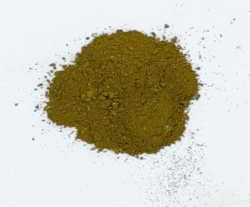Nickel(II) thiocyanate
 Sample of nickel(II) thiocyanate
| |
 Crystal structure of nickel(II) thiocyanate
| |
| Identifiers | |
|---|---|
3D model (JSmol)
|
|
| ChemSpider | |
| ECHA InfoCard | 100.033.808 |
| EC Number |
|
PubChem CID
|
|
CompTox Dashboard (EPA)
|
|
| |
| |
| Properties | |
| Ni(SCN)2 | |
| Molar mass | 174.86 g/mol[1] |
| Appearance | green-brown powder |
| Density | 2.59 g/cm3[1] |
| Melting point | decomposes[1] |
| 5×10−3 cm3/mol[2] | |
| Structure | |
| Hg(SCN)2 structure | |
| Octahedral | |
| Hazards | |
| GHS labelling: | |
  
| |
| Danger | |
| H317, H334, H341, H350i, H360D, H372, H410 | |
| P201, P202, P260, P261, P264, P270, P272, P273, P280, P281, P285, P302+P352, P304+P341, P308+P313, P314, P321, P333+P313, P342+P311, P363, P391, P405, P501 | |
| Related compounds | |
Other anions
|
|
Other cations
|
|
Except where otherwise noted, data are given for materials in their standard state (at 25 °C [77 °F], 100 kPa).
| |
Nickel(II) thiocyanate is a coordination polymer with formula Ni(SCN)2. It is a green-brown solid and its crystal structure was determined first in 1982.[1]
Structure
[edit]The structure of Ni(SCN)2 was determined via single-crystal X-ray diffraction and consists of two-dimensional sheets held together through Van der Waals forces. It belongs to mercury thiocyanate structure-type and can be considered a distorted form of the NiBr2 (CdI2) structure. Each nickel is octahedrally coordinated by four sulfurs and two nitrogens. The sulfur end of the SCN− ligand is doubly bridging.[1]
Synthesis
[edit]Nickel(II) thiocyanate can be prepared via the reaction of barium thiocyanate and nickel sulfate solutions. After removal of the precipitated barium sulfate, the solution is allowed to evaporate leaving microcrystalline Ni(SCN)2.[3][4]
Magnetism
[edit]Nickel(II) thiocyanate, like nickel(II) iodide, nickel(II) bromide and nickel(II) chloride, is an antiferromagnet at low temperatures.[2]
References
[edit]- ^ a b c d e Dubler, Erich; Relier, Armin; Oswald, H. R. (1982-01-01). "Intermediates in thermal decomposition of nickel(II) complexes: The crystal structures of Ni(SCN)2(NH3)2 and Ni(SCN)2". Zeitschrift für Kristallographie – Crystalline Materials. 161 (1–4): 265–278. doi:10.1524/zkri.1982.161.14.265. ISSN 2196-7105. S2CID 201671776.
- ^ a b DeFotis, G. C.; Dell, K. D.; Krovich, D. J.; Brubaker, W. W. (1993-05-15). "Antiferromagnetism of Ni(SCN)2". Journal of Applied Physics. 73 (10): 5386–5388. Bibcode:1993JAP....73.5386D. doi:10.1063/1.353740. ISSN 0021-8979.
- ^ Geers, Madeleine; Jarvis, David M.; Liu, Cheng; Saxena, Siddharth S.; Pitcairn, Jem; Myatt, Emily; Hallweger, Sebastian A.; Kronawitter, Silva M.; Kieslich, Gregor; Ling, Sanliang; Cairns, Andrew B.; Daisenberger, Dominik; Fabelo, Oscar; Cañadillas-Delgado, Laura; Cliffe, Matthew J. (2023). "High-pressure behavior of the magnetic van der Waals molecular framework Ni(NCS)2". Physical Review B. 108 (14) 144439. arXiv:2309.04477. Bibcode:2023PhRvB.108n4439G. doi:10.1103/PhysRevB.108.144439.
- ^ Bassey, Euan N.; Paddison, Joseph A. M.; Keyzer, Evan N.; Lee, Jeongjae; Manuel, Pascal; Da Silva, Ivan; Dutton, Siân E.; Grey, Clare P.; Cliffe, Matthew J. (2020). "Strengthening the Magnetic Interactions in Pseudobinary First-Row Transition Metal Thiocyanates, M(NCS)2". Inorganic Chemistry. 59 (16): 11627–11639. doi:10.1021/acs.inorgchem.0c01478. PMID 32799496.